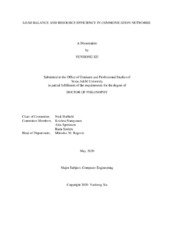| dc.description.abstract | Network management is critical for today’s network. This study investigates both load balancing and resource efficiency in network management.
For load balancing, one unfavorable situation is that the active traffic uses a portion of the equal-cost paths instead of all. The root causes of load imbalance are not easily identified and located by network operators. Most research work related in this area concerns the design of load balancing mechanisms or network-wide troubleshooting that does not specify the causes of load imbalance. In this study, we describe a computational framework based on network measurements to identify the correlation mechanism causing the load imbalance. We also describe a novel framework based on Coprime to mitigate the load imbalance brought by hash correlations. In evaluation based on real network trace data and topologies, we have proved that we can reduces the error (CV or K-S statistic) by at least one magnitude.
For resource efficiency, today’s network demands an increasing switch memory to support the essential functions, such as forwarding, monitoring, etc. However, the cache memory is restricted when processing data streams in which the input is presented as a sequence of items and can be examined in only a few passes (typically just one). This study introduces a new single-pass reservoir weighted-sampling stream aggregation algorithm, Priority-Based Aggregation (PBA). A naive approach to order sample regardless of key then aggregate the results is hopelessly inefficient. In distinction, our proposed algorithm uses a single persistent random variable across the lifetime of each key in the cache and maintains unbiased estimates of the key aggregates that can be queried at any point in the stream. Concerning statistical properties, we prove that PBA provides unbiased estimates of the true aggregates. We analyze the computational complexity of PBA and its variants and provide a detailed evaluation of its accuracy on synthetic and trace data.
In addition to sampling, this study also considers placing classification rules into switches from various network functions. While much work has focused on compressing the rules, most of this work proposes solutions operating in the memory of a single switch. Instead, this study proposed a collaborative approach encompassing switches and network functions. This architecture enables trade-off between usage of (expensive) switch memory and (cheaper) downstream network bandwidth and network function resources. Our system can reduce memory usage significantly compared to strawman approaches as demonstrated with extensive simulations and prototype evaluation with real traffic traces and rules. | en |


